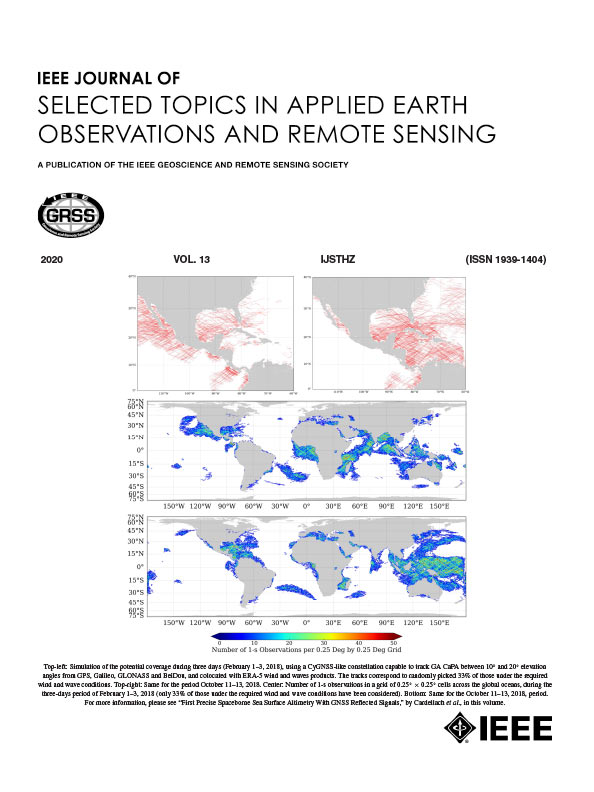利用DInSAR位移积分法监测东南极洲大卫冰川区冰下湖泊活动
IF 5.3
2区 地球科学
Q1 ENGINEERING, ELECTRICAL & ELECTRONIC
IEEE Journal of Selected Topics in Applied Earth Observations and Remote Sensing
Pub Date : 2025-08-21
DOI:10.1109/JSTARS.2025.3601588
引用次数: 0
摘要
冰下湖泊显著影响冰盖动态,因此需要对其活动进行精确监测。本研究提出了一种新的方法,该方法集成了来自Sentinel-1数据的差分干涉合成孔径雷达(DInSAR)位移,以估计与冰下湖活动相关的冰盖表面高程变化的高分辨率时间序列。将该方法应用于2016 - 2023年东南极洲David冰川地区,对David2湖和新发现的David2-1和DavidA冰下湖的活动进行了识别和分析。由DInSAR位移积分得到的冰盖高程变化与冰、云和陆地高程卫星-2观测结果非常吻合,并允许对冰下湖泊活动进行详细监测。2016年初,由于湖泊填充,戴维达湖上方的冰盖表面明显上升,随后一直稳定到2020年。由于排水,2020年底出现了快速的地表下降。自2021年以来,地表下降速度继续放缓,表明水位逐渐下降。戴维湖2-1在2021年初被填满,随后呈现出排水和填充交替的状态。在2020年之前,大卫湖2上方的冰盖表面呈现出持续的隆起,这是由于持续的蓄水,然后过渡到排水阶段。水力电位衍生的基底水通道表明,大卫湖可能由未探测到的流入水提供,而大卫湖2主要从南部通道而不是从大卫湖2-1接收水。该研究证明了时间序列DInSAR在冰下湖泊监测中的有效性,克服了仅限高程观测的局限性,并提供了对冰下水文和冰盖动态的见解。本文章由计算机程序翻译,如有差异,请以英文原文为准。
Monitoring Subglacial Lake Activity in the David Glacier Region, East Antarctica, Using a DInSAR Displacement Integration Approach
Subglacial lakes significantly influence ice sheet dynamics, necessitating precise monitoring of their activity. This study presents a novel approach that integrates differential interferometric synthetic aperture radar (DInSAR) displacements from Sentinel-1 data to estimate high-resolution time series of ice sheet surface elevation changes associated with subglacial lake activity. Applying this approach to the David Glacier region in East Antarctica from 2016 to 2023, we identified and analyzed the activity of Lake David2 and newly identified subglacial lakes, David2-1 and DavidA. The ice sheet elevation changes derived from the DInSAR displacement integration showed strong agreement with Ice, Cloud, and land Elevation Satellite-2 observations and allowed for detailed monitoring of subglacial lake activity. The ice sheet surface above Lake DavidA showed a marked rise in early 2016 due to lake filling, followed by a stable period until 2020. A rapid surface decline occurred in late 2020 due to drainage. Since 2021, the surface decline has continued at slower rates, indicating gradual water level lowering. Lake David2-1 filled by early 2021 and subsequently exhibited alternating drainage and filling. The ice sheet surface above Lake David2 exhibited sustained uplift until 2020, attributed to continuous water filling, and then transitioned to a phase of drainage. Hydraulic potential-derived basal water pathways suggested that Lake DavidA was likely supplied by undetected inflows, while Lake David2 primarily received water from a southern pathway rather than from Lake David2-1. This study demonstrates the effectiveness of time-series DInSAR for subglacial lake monitoring, overcoming limitations of altimetry-only observations and providing insights into subglacial hydrology and ice sheet dynamics.
求助全文
通过发布文献求助,成功后即可免费获取论文全文。
去求助
来源期刊
CiteScore
9.30
自引率
10.90%
发文量
563
审稿时长
4.7 months
期刊介绍:
The IEEE Journal of Selected Topics in Applied Earth Observations and Remote Sensing addresses the growing field of applications in Earth observations and remote sensing, and also provides a venue for the rapidly expanding special issues that are being sponsored by the IEEE Geosciences and Remote Sensing Society. The journal draws upon the experience of the highly successful “IEEE Transactions on Geoscience and Remote Sensing” and provide a complementary medium for the wide range of topics in applied earth observations. The ‘Applications’ areas encompasses the societal benefit areas of the Global Earth Observations Systems of Systems (GEOSS) program. Through deliberations over two years, ministers from 50 countries agreed to identify nine areas where Earth observation could positively impact the quality of life and health of their respective countries. Some of these are areas not traditionally addressed in the IEEE context. These include biodiversity, health and climate. Yet it is the skill sets of IEEE members, in areas such as observations, communications, computers, signal processing, standards and ocean engineering, that form the technical underpinnings of GEOSS. Thus, the Journal attracts a broad range of interests that serves both present members in new ways and expands the IEEE visibility into new areas.

 求助内容:
求助内容: 应助结果提醒方式:
应助结果提醒方式:


